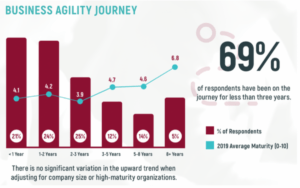“I am responsible for doing daily standups with my team but one team member resists.” said one young Agile coach. “Why does he resist?” exclaimed a group of Agile coaches. “I do not know really. He simply does not want to stand up and do daily standups. That team member is a very senior employee and I am quite a young Agile coach. Maybe he thinks that he should not follow a young employee like me. Still, I insist that he stands up to do the daily standup.” responded the Agile coach in a very frustrated manner. This was a conversation I heard in a session of an Agile business meeting in Europe. This might be a challenge faced by some organisations going through an Agile transformation.
Many organisations start their Agile transformations by implementing Agile practices (e.g. scrum, kanban, design thinking, etc), while they maintain a bureaucratic mindset. That is one of the reasons why many Agile transformations fail. According to the 13th Annual State of Agile report, the biggest barrier to adopting Agile is organisational culture.


Numerous experts define Agile differently. Steve Denning is one of the leading business thinkers in the world and his definition captures the essence of Agile. According to Denning, an organisation is Agile, when that organisation a. continuously provides customer value, b. has small and cross-functional teams working in short cycles and c. the whole organisation operates as networks of small teams. If any of these three values is missing, an organisation is not Agile. Below you can see three challenges of Agile transformations as well as three actionable ideas to deal with them.
Imposing Agile: In many organisations, managers decide to adopt Agile and select a method such as Scrum to start with. A specific method is imposed on employees. We then see many teams doing the rituals of Agile such as daily standups without having an Agile mindset at all. In this article, Denning states: “Some instances of supposedly agile management have as much relation to real Agile as someone wearing flamenco costumes and talking about flamenco, without having mastered flamenco dance steps or displaying a feel or flair for flamenco music.”
Takeaway for leaders: Understand & embrace the essence of Agile and enable employees to adopt Agile without imposing any tool on them. Simply allow them to work with any tool or method as long as it helps your organisation to continuously add value to customers, work in short cycles and allow the whole organisation to work in that way.
Mainly individual-based incentives: In certain organisations, incentives are based on individual performance. This might have a negative effect on employees’ collaboration with one another. Collaboration and cross-functional work are crucial in Agile to be able to continuously add value to customers.
Takeaway for leaders: In addition to individual-based incentives, include team-based ones to help strengthen collaboration within and across teams.
Lack of “Why”: Unmotivated employees is another challenge organisations face in their Agile transformations. Employees sometimes do not know why their organisation strives to be Agile or employees are not involved in creating this change. Therefore, the chances of resistance to Agile adoption can be bigger.
Takeaway for leaders: Make sure employees know why they are implementing Agile. Help them articulate a motivation for adopting Agile.
In fact, Agile transformation is a journey and it takes time. According to 2019 Business Agility Report, the longer the business agility journey, the bigger the chance to be Agile, that is to have a higher business agility level.


People Operations or HR can help expand an Agile mindset throughout an organisation and create & maintain a learning organisation which continuously adds value to its customers. This way, an organisation is more likely to move from “doing Agile” to becoming Agile.
This article was originally published on The HR Observer.





